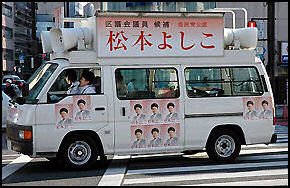ELECTIONS IN JAPAN
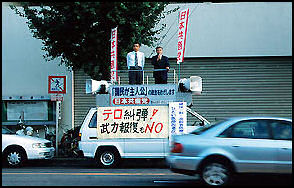
General elections are national election in which every seat in the lower house is contested. They are held under two conditions: 1) if there is a no confidence vote by Parliament or 2) the Prime Minister dissolves Parliament and calls an election. The Prime Minister can call an election at any time within a four year period after the previous election. The last one was in August 2009. The ones before that were in September 2005, November 2003 and June 2000. The next has to be called by August 2013.
No confidence votes are rare. They are brought by the opposition party when the ruling party is unable to get a bill passed and thus is viewed as unable to govern. If a no confidence vote occurs the ruling party then resigns and a new election is called. In most cases, elections are held when they are called by the Prime Minister. Generally, if the ruling party's poll numbers are high, and its been a while since the last election, the Prime Minister will call an election. If the poll ratings of the ruling party are low they will usually hold on to power as long as they can and call an election as late as possible. See Dissolving Parliament in the article JAPANESE PRIME MINISTER, CABINET AND PARLIAMENT (THE DIET)
Upper House elections are held every three years with half the 242 seats being contested in one election. Upper house members have traditionally had little impact on power and policy. Even so upper house elections have been widely viewed as indicators of satisfaction or dissatisfaction with the ruling party and as mandates or condemnations of the people in power. The last upper house election was in July 2007. The one before that was in July 2004. The next one is July 2010.
Otherwise there are elections all the time in Japan. It seems like elections for mayors or local assemblies or individual parliament seats are held three or four times a years and small local elections for a vacated seats or this and that are held every other weekend.
Websites and Resources
Good Websites and Sources: Photos of Elections and Right Wing Extremists National Diet Building at Japan-Photo Archive japan-photo.de ; Elections in Japan afe.easia.columbia.edu/japan ; Government and Politics in Japan, Library of Congress Report from the Early 1990s countrystudies.us/japan ; Wikipedia article on Politics in Japan Wikipedia ; Japan Politics Central jpcentral.virginia.edu ; Japan Watch, Commentary on Political and Economic Issues jipr.org ;Links and Sources on Japanese Politics politicalresources.net/japan ; Inside Japanese Politics (Last updated in 2004) asahi.com/ ; Documents Related to Postwar Politics and International Relations ioc.u-tokyo.ac.jp ; Why Japanese Politicians Are So Bad Newsweek ; Political Inheritance Under Single Vote System allacademic.com ; Female Politicians in Japan elpweb.com/onjapan ; Inherited Seats news.bbc.co.uk
Journals and Books Japan Echo, a Journal on Japanese Politics and Society japanecho.com ; Japan Policy Research Institute jpri.org ; Electronic Journal of Japanese Studies http://www.japanesestudies.org.uk/ ; In Depth Analysis of Japanese Politics transpacificradio.com ; Books on Politics in Japan infibeam.com
Links in this Website: GOVERNMENT AND SYMBOLS IN JAPAN Factsanddetails.com/Japan ; JAPANESE PRIME MINISTER AND PARLIAMENT Factsanddetails.com/Japan ; POLITICS AND ELECTIONS IN JAPAN Factsanddetails.com/Japan ; POLITICIANS IN JAPAN Factsanddetails.com/Japan ; BUREAUCRACY IN JAPAN Factsanddetails.com/Japan ; CORRUPTION AND GOVERNMENT SCANDALS IN JAPAN Factsanddetails.com/Japan ; TAXES, WELFARE AND SOCIAL SECURITY IN JAPAN Factsanddetails.com/Japan ;
Good Websites Government and Sources: Wikipedia article on the Government of Japan Wikipedia ; Wikipedia article on the Japanese Flag Wikipedia ; Government Organization Chart kantei.go.jp and kantei.go.jp/foreign/link/chart ; Statistical Handbook of Japan Government Chapter stat.go.jp/english/data/handbook ; 2010 Edition stat.go.jp/english/data/nenkan ; News stat.go.jp Governments on the WWW? Japan Linksgksoft.com ; Japan Echo, a Journal on Japanese Politics and Society japanecho.com ; Electronic Journal of Japanese Studies japanesestudies.org
Prime Minister, Legislature and Leaders: CIA List of Current World Leaders /www.cia.gov/library ; Kantei, Office of the Prime Minister kantei.go.jp ; Cabinet Office cao.go.jp ; House of Representatives (Shugiin) shugiin.go.jp ; House of Councillors (Sangiin) sangiin.go.jp/ ; National Diet Library ndl.go.jp/en National Diet Building in Tokyo Photos of National Diet Building at Japan-Photo Archive japan-photo.de ; Wikipedia Wikipedia ; Japan Visitor Japan Visitor ; Japanese Lifestyle japaneselifestyle.com.au Constitution Constitution of Japan solon.org/Constitutions/Japan ; Birth of the Constitution of Japan ndl.go.jp/constitution ; Research Commission on the Constitution shugiin.go.jp ;
Upper House Elections
Upper house elections are held every three years, with half the chamber’s 242 seats up for grabs in a given election. Voters cast two votes on election day. Of the 121 contested seats in the the July 2010 election, 73 were filled by winners from the 47 prefecture-based electoral districts and the remaining 48 seats by candidates chosne under the nationwide party-list proportional representation system. [Source: Kyodo news]
In the upper house; triennial election system, 29 electoral districts — more than half of Japan’s 47 prefectural districts — have one seat each up for grabs, while two seats are allocated to 12 prefectures, with three seats to five prefectures, and the largest number, five seats, to Tokyo. Under the proportional representation system, voters can vote either for a political party or a candidate of their choice from candidates registered by parties under an open-list system. Upper house seats given to candidates on the party lists are allocated to the parties according to the number of votes they received.
Single-Seat Constituencies, Proportional Representation and Early Balloting in Japan
Lower house members are elected through two types of elections. One is "single-seat electoral districts" that have been set up by dividing the country into 300 constituencies, in each of which one first-past-the-post candidate is elected to the lower chamber. The other is "proportional representation," which was established by splitting the country into 11 regions, in which people vote for parties. Those who have the right to vote are called "eligible voters" or simply voters. The number of voters in each single-seat electoral district varies from one constituency to another. [Source: Yomiuri Shimbun, March 6, 2012]
Jiji Press reported: “A total of 12,039,570 voters cast their ballots in early voting for the December 2012 House of Representatives election, the Internal Affairs and Communications Ministry said. The number fell 13.9 percent from 13,984,085 for the election in 2009. The proportion of voters using the early voting system accounted for 11.5 percent of the country's total voting population of about 104.36 million, down from 13.5 percent. The early voting system allowed voters to cast their ballots between Dec. 5, one day after the election campaign for candidates started, and the day before the election. The number of early voters surged for the 2009 lower house election. But this time, the figure fell for the first time since early voting was first adopted for a lower house election in 2005. [Source: Jiji Press, December 17, 2012]
The early voting system was introduced in 2003 to boost voter turnout by allowing voters who cannot visit polling stations on the election day for various reasons as such as work, travel, and ceremonial occasions including weddings and funerals, to cast their ballots beforehand in their own electoral districts. This time, the system was utilized especially in areas devastated by the March 2011 earthquake and tsunami. In Miyagi and Fukushima prefectures, election boards set up temporary polling stations at evacuation areas so that those in temporary housing could cast ballots there.
Voter Disparity in Japan
The uneven spread in the number of voters across single-seat electoral districts nationwide is known as "disparity in the weight of votes" or vote disparity. The disparity can be quite wide. In the lower house election in August 2009, the number of voters in Chiba Constituency No. 4 in Chiba Prefecture was 2.3 times that of Kochi Constituency No. 3 in Kochi Prefecture. Given that all voters have an equal right to vote, the weight of the vote in Chiba No. 4 single-seat constituency is conspicuously lower than that in Kochi No. 3 district.
In Japan there is sometimes a large voter disparity between rural districts and urban districts with rural voters get more bang per vote than urban voters. The Yomiuri Shimbun reported: “The largest disparity in the value of votes in single-seat constituencies for the House of Representatives was 2.482-to-1 between the least-populated Kochi Constituency No. 3 and the most-populated Chiba Constituency No. 4, with the gap growing by 0.04 point from the previous year, according to Yomiuri Shimbun preliminary estimates based on the ministry's population data. The population in Kochi No. 3 stood at 242,976 compared with 602,996 in Chiba No. 4. [Source: Yomiuri Shimbun, August 9, 2012]
Meanwhile, the disparity with the least populated Kochi Constituency No. 3 exceeded 2-to-1 in 84 constituencies, up 11 from the previous year. The 11 constituencies were: Miyagi No. 1, Tokyo No. 20, Nagano No. 3, Saitama No. 9, Chiba Nos. 1, 7 and 9; Tochigi No. 4, Hokkaido No. 9, and Osaka Nos. 13 and 15.
Vote disparities for House of Councillors elections were largest between Tottori and Kanagawa prefectures at 5.049-to-1, with the gap growing by 0.036 point from the previous year. Tottori Prefecture has two upper house seats with an average of 294,358 people per lawmaker, while Kanagawa Prefecture has six seats for which the average figure was 1,486,228.
Plan to Cut Vote Disparity
In March 2011, the Supreme Court ruled that such a gap is unfair and that efforts should be made to reduce vote disparity to less than 2-to-1 between the most and least represented constituencies. The Democratic Party of Japan and the Liberal Democratic Party have proposed reducing the number of single-seat electoral districts in some regions. Other parties, however, argue for an overhaul of the lower house electoral system. With no progress on settling these differences in sight, a government-appointed team tasked with newly rezoning electoral districts is finding it difficult to do its job.
The Democratic Party of Japan has submitted legislation in 2012 to reform the lower house electoral system to rectify the vote disparities, which includes proposals to eliminate one single-seat constituency in five prefectures, cut 40 lower house seats from proportional representation blocs, and introduce a new system for allocating proportional representation seats in lower house elections.
In July 2012, the Yomiuri Shimbun reported: “The Democratic Party of Japan and the Liberal Democratic Party have agreed over a proposal to rectify the vote-value disparity in the upper house that would see a total of four seats taken away from two overrepresented prefectures and a total of four added to two underrepresented prefectures. The two parties endorsed the plan at a meeting of the upper house's electoral system reform consultation council. [Source: Yomiuri Shimbun, July 27, 2012]
“The plan would see a two-seat increase in each of the Kanagawa and Osaka prefectural constituencies and a two-seat reduction in the Fukushima and Gifu prefectural constituencies. With no changes in the nationwide proportional representation, the number of seats in the upper house would remain at 242. Currently, the disparity is greatest between Tottori and Kanagawa prefectures, at 1-to-5.124. After the proposal is implemented, the largest disparity will be 1-to-4.746, between Tottori and Hyogo prefectures. The proposal also stipulates the addition of a clause to the bill that parties will consider an overhaul of the electoral system in time for the 2016 upper house election, as the proposal only slightly adjusts the vote-value disparity.
Preparation of General Elections in Japan
Describing the preparations for the December 2012 lower house election, the Yomiuri Shimbun reported: “Not only political parties and would-be candidates but also government organizations and firms providing election-related products are rushing to prepare for the suddenly announced upcoming House of Representatives election. Ahead of the polls local election administrative committees and businesses who must provide the logistical means to hold the election have been very busy. Employees of Mukaida Co., a firm based in Fujieda, Shizuoka Prefecture, that manufactures and sells aluminum products, were extremely busy manufacturing ballot boxes. [Source: Yomiuri Shimbun, November 25, 2012]
In municipalities where local elections will be held on the same day, resulting in two or three simultaneous elections, local governments are worried about how to secure personnel for vote counting. In the lower house election, each polling station will require three ballot boxes--one for constituency votes, one for proportional representation votes and the last for evaluation of Supreme Court Justices. If elections for local government officials or assemblies are held simultaneously, additional ballot boxes, one for each poll, must be provided.
Mukaida Co., which will provide ballot boxes, originally predicted the lower house election voting would be held after the New Year, and thus planned to begin its work in December. But contrary to the company's prediction, the lower house election has been scheduled for before the year-end, so the company hurried to began manufacturing the boxes. Hiroshi Mukaida, 42, the company's president, said: "I've been flooded with telephone calls. As soon as I hang up, the phones immediately start ringing again. Though we haven't been able to procure all the materials we need, I want to finish on time.”
Municipal governments in Tokyo, which have a total of more than 10 million voters, will hold the lower house election and a Tokyo gubernatorial election on the same day in those wards. Setagaya Ward, Katsushika Ward, and Hachioji face an especially tough situation because by-elections for the metropolitan assembly will be held on the same day.
In Hachioji, a city with about 450,000 voters, the municipal election administrative committee has estimated that about 1,500 staffers will be needed for vote counting. But the city government has not had time to hire temporary staffers to cover the work, as the election schedules were decided in immediate succession after former Gov. Shintaro Ishihara suddenly announced his resignation. When the vote counting is done on Dec. 16, many city government officials will have to work on Sunday, which is usually their day off.
In Setagaya Ward, the ward office will increase the number of staff for the vote counting by 50 percent to 1,300. Despite the measure, efficiency is expected to improve only slightly. The ward's election administrative committee predicts that it will take until sometime before dawn to count all the ballots. An official on the committee said, "It will be good if we are able to finish by dawn.”
In Uji, Kyoto Prefecture, the date of a mayoral election and a by-election for the city assembly, which were initially scheduled for Dec. 9, have been changed to Dec. 16. The city government expects that doing so will raise voter turnouts, but the decision has also created problems. Paper ballots were already printed with the date of the mayoral poll listed as Dec. 9, but all of them must be discarded. The city government must now print new ballots with the poll date listed as Dec. 16. Furthermore, the dates listed on election posters that have already been posted in about 320 locations must also be changed, a task that should keep city government officials busy every day in the near future.
Election Logistics in Japan
The voting age in Japan is 20. Twenty is also the legal are for drinking, smoking, betting at horse tracks, signing contracts and getting married without parental consent. There has been some discussion of lowering the legal age to 18 but the idea has received a lot of opposition. The driving age in Japan is 18.
National elections are held on Sunday. A total of 50,314 polling stations were used in the upper house election in July 2010, about 3,000 less station than were used in 2000. The voting lasts from 7:00am to 8:00pm. Voters write out the names of the candidates and party they want on paper ballots and fold them and place them in a box. E-voting is allowed in local and national elections for absentee voters. Vote counting begins immediately after the polls close. The result are generally known by around midnight.
After a 1993 bribery scandal the lower house electoral system of single-seat districts was reformed so voters vote for individual candidates in single seat districts and a party in a proportion representation system (See Reforms Below). In November 2003 lower house election, there were 1,159 candidates vying for 300 seats in single seat constituencies and 180 proportional representation seats.
Electronic voting using a touch screen is being eyed for national elections. There has been a lot of resistance to introducing electronic voting in Japan out of fears about tampering and what will happen to voting records if there is some sort of glitch.
Election results are usually announced very quickly even though they are often tallied by hand. After the polls close local governments often compete among themselves to see who can count votes the fastest. It is not unusual for all the ballots to be counted in 20 to 25 minutes and announced within an hour after the polls close.
Voting before an election is becoming increasingly common in Japan . A record 12 million voters cast early ballots in the 16-day period before the election in July 2010.
High-Speed Vote Counting
In a local Tokyo election, the Hachioj Municipal election Board counted about 258,000 ballots in one hour and 44 minutes — or 2,486 votes per minute. The election board achieved the quick result using 13 automatic ballot counting machines and, according to the Yomiuri Shimbun, by following a “a fine-tuned, minute-by-minute schedule to keep all election board staff busy, ordering staffers who were in charge of adding up the votes to also help count the votes.”
To increase counting speed some elections boards adjust table heights and lay down black table clothes to make voting slips easy to read. In the city of Komoro a counting machine malfunctioned because of sweat dripping off election officials. After that voting staff were required to wear head bands. [Source: Yomiuri Shimbun]
Inherited Seats in Japan and the Three Ban
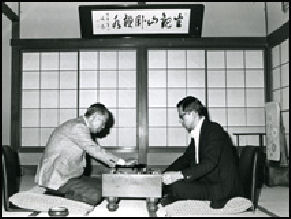
Prime Minister Fukuda with
future Prime Minister Fukuda It is often said that to be elected to the Diet in Japan you need the "three ban": 1) “jiban” (a local power base); 2) “kanban” (name recognition) and 3) “kaban” (finances). One of the easiest ways to gain these three things is to come from a political family. Traditionally about 30 percent of the members of the lower house have inherited their seats from their fathers, grandfathers and even great grandfathers. The remainder are often hand picked by the leaders of the parties.
The Yomiuri Shimbun defines a hereditary lawmaker or candidate as one who inherits a political base or public recognition in the constituency of a relative with blood relation within three generations, or a relative of their spouse within two generations.
As of June 2009, under the Yomiuri Shimbun criteria, 107 of 303 LDP lower house members were “hereditary” lawmakers while 16 of the 116 DPJ lower house members were. Eleven of the 17 member of Prime Minister Taro Azo’s cabinet and 130 of the 478 members of the lower house could be considered “hereditary.”
Prominent Politicians and Hereditary Seats in Japan
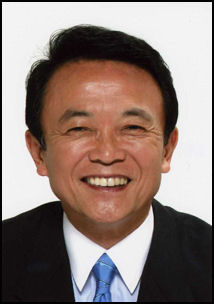
Prime Minister Taro Aso Many prime ministers — including Aso, Koizumi and Hashimoto — came from political families. Aso’s grandfather on his mother’s side is former Prime Minister Shigeru Yoshida (1878-1967), arguably the most important postwar prime minister, who in turn was a descendant of Toshimichi Okubo, one of the important figures in the Meiji Restoration in the 19th century. Aso’s wife is the daughter of former Prime Minister Zenko Suzuki. Aso’s father was lower house member. His sister is married to Prince Tomohito of Mikasa, a cousin of the Emperor.
Key opposition members from political families. Ichiro Ozawa’s father was a construction minister. The father, grandfather and great grandfather of Yukio Hatoyama served as foreign minister, prime minister and lower house speaker, respectively.
Most "hereditary candidates” are easily elected. Among those running for the first time in 2000 was daughter of the recently deceased Prime Minister Kezo Obuchi. During the campaign she told voters, “I’m Yuko Obuchi. I’m only 26 years old. I will do my best. Please give me your support!” Voters called her Yoko-chan, using the Japanese diminutive.
Hereditary Seat Reform in Japan
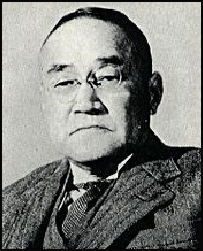
Aso's grandfather
Prime Minister Yoshida The members with inherited seats are often linked by strategic marriages with prominent industrial leaders. Many critics contend this form or politics is a modern form of feudalism. The system prevents people from a variety of backgrounds participation on politics and keeps the same old boys in power.
One analyst quoted in the Yomiuri Shimbun said such lawmakers “haven’t experienced the hardships that nurture perseverance within them” but at the same time they can devote more attention to making policy because they do not need to build a support base from scratch by making a lot of promises and building up a system of patronage.
The DPJ wants to pass legislation banning hereditary candidates in “the same electoral districts in a back-to-back way,” in other words having a relative take over a seat immediately after lawmaker retires or dies as Yuko Obuchi did above and Koizumi did with his sone when he retired. If this legislation is enacted it would only affect first time candidates and not affect those who already have seats.
Election Reforms in Japan
Electoral reforms were passed in 1993-1994 while the LDP was briefly ousted from power and debate on the issue was triggered by a 1993 bribery scandal involving construction firms and leading politicians such Shin Kanemaru.
The reforms created small single-seat districts, set limits on political donations, and set aside some seats filled through a proportional representation system. In the lower house 300 seats are elected in single set districts and 180 seats are elected through proportion representation. Th reforms have meant that parliament members now represent smaller districts than they used and have less authority over spending decisions and that these members have less of a need to scramble for political donations.
Voters in a single election vote for individual candidates in single seat districts and parties in the proportion representation. Candidates with the most votes win the district seats. The seats in the proportional representation part of election are awarded on a percentage basis to a party based on the percentage of the vote won by that party. It is possible for an individual to lose their seat in an election but become a representative as a member of the party. Before the reforms people voted for one candidate in a large district and the top three of four candidates from that district won seats.
The new system was first used in the 1996 election. It diminished the power of the factions and rural areas, gave small parties a better chance to win some seats and made is easier for new parties and alliances to form and reform.
In February 2010, a government panel began work redrawing the boundaries of single-seat districts to reduce regional disparities that give voters in some rural districts more relative power than those in urban districts.
Voting Patterns and Turnout in Japan

The Japanese voting public often votes more based on their individual, local group and regional needs than on the needs the country as a whole.
The political system has traditionally given proportionally more power to small towns and rural areas. The system favors rural areas because the districts were drawn up a considerably time ago and have made only minimal adjustments for population changes. This means that rural districts whose population has remained fairly stable or even shrunk have the same power as an urban districts whose population has grown in recent decades. In some cases a parliament members from a rural district have one fifth the constituents as members from districts in Tokyo.
Traditionally, the Japanese have responded to corruption and political paralysis with apathy rather than disgust. Often troubled parties and candidates continue to get elected because voters are reluctant to back new candidates. This attitude is starting to change. Some voters are starting to rebel against entrenched politicians. Demonstrations and grassroots movements are now more popular.
Opposition parties are at a disadvantage because they have a hard time attracting talented or qualified local candidates because of their weakness in attracting subsidies and pork barrel links to the LDP-dominated central government.
Voter turnout was 67. 2 percent in 2005, up from 59.9 percent in the last election in 2003 but down from 78 percent in 1956. The low turnout favors extremist parties and parties with support from religious groups who are better able to get out the vote.
The highest voter turnout for lower house elections was in 1958 when 77 percent of voters voted. The lowest of 59.6 percent was in 1996.
Turnout by age in the 2005 election: 1) 20s (46 percent); 2) 30s (60 percent); 3) 40s (72 percent); 4) 50s (78 percent); 5) 60s (83 percent); 6) 70s (79 percent); 7) 80s and older (53 percent).
The voter turnout rate among young voters is very low (between 30 and 40 percent for votes under 30 in recent elections) while the turnout among voters in their 60s or above is high (70 to 80 percent). This situation has prompted some students to take action such as organize get-out-the-vote rock concerts and launch Internet and e-mail campaigns to increase voter turn out among the young so that politicians address the concerns of young people and don’t enact policies that are favorable to old people now but young people have to pay for in the future.
Voter turn out is said be highest when the weather is overcast. In nice weather people tend to go out and enjoy themselves. When it is rainy they stay in. One survey of five lower house elections over 16 years found that voter turnout was highest (65.5 percent) when the weather was cloudy and lowest (56.5 percent) when it was sunny. During the other three elections which were cloudy with rain the turn out was over 60 percent.
Campaigns in Japan
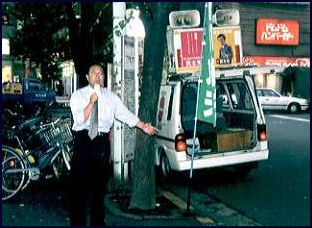
Candidate giving a speech An election is held a maximum of 40 days after the lower house is dissolved. Campaigns for seats in the important lower house elections run for only 12 days, with the campaigning officially stopping on the Saturday before the Sunday election. Much of the campaigning is done by local supporter associations, known as “koenkai”, made up of local politicians, businessmen, prominent citizens and rank-and-file members. Members of these groups generally favor the status quo and are resistant to change. They are often tied in somehow to local pork barrel patronage system.
Traditional Japanese campaigns feature vans with loudspeakers that blast out the candidates name and promises to "do my best" and small groups of supporters that go through neighborhoods putting up campaign posters and bowing respectfully to passers by. Speeches are sometimes made by candidates on the back of flatbed trucks with cheerleading squads in the background.
In campaigns, candidates hold microphones taped together and give short speeches and pump their hands in the air as they lead rally cries. Parties present manifestos with proposed programs and polices and debate them on the floor of the legislatures. Major candidates appear on news shows and talk shows and increasingly are turning to paid television commercials to get their message out.
Because there is so little time to prepare and campaign, political organizers try to anticipate the dates for elections the best they can and prepare accordingly. One of the first steps for local representatives is to set up an office. If they do this too late they might get caught unprepared. If they do it too early they might waste money unnecessarily.
The campaign period for the upper house election in July 2007 was 17 days. During the 12 day campaign period to chose a new LDP president, candidates went around the country on the same planes and buses, giving speeches and holding debates.
Campaigns and the Media in Japan
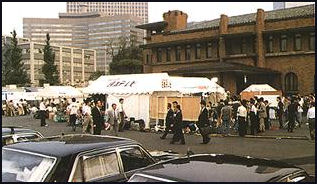
press tents outside Prime Minister's office Japanese politicians were not allowed to make political television commercials until 1996. Before that time politicians were limited to appearances in bland panel discussions. Every year there are more and more political advertisements on television. Newspaper articles about politicians list blood type, weight, hobbies and likes and dislikes. Criticizing opponents by name is considered rude and obnoxious and few politicians do it. The is currently a ban on insuring the Internet for campaigning, Both parties want to see the restrictions lifted.
In recent elections, political advertising on television has been a fixture of the campaigns with commercials for the candidates running almost as frequently as they do in the United States campaigns. Studies by the CM research Center in Tokyo suggest there is strong correlation between the likability of the ads and the performance of the candidates. Before upper house ejections in 2007 the likability of the ads by opposition DPJ was much higher than that of likability of the ads of the ruling LDP. The DPJ surprised every by winning th election, taking 80 seats, while the LDP won only 37.
Image Sources: 1) 5) June at Goods from Japan 2) 3) 4) 6) 7) 8) Kantei, office of Prime Minister 9) Ray Kinnane 10) Greenpeace, campaign pictures, Japan-Photo.de
Text Sources: New York Times, Washington Post, Los Angeles Times, Daily Yomiuri, Times of London, Japan National Tourist Organization (JNTO), National Geographic, The New Yorker, Time, Newsweek, Reuters, AP, Lonely Planet Guides, Compton’s Encyclopedia and various books and other publications.
Last updated January 2013


